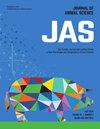Changes in the skeletal muscle transcriptome due to the intramuscular administration of lidocaine in wether lambs
IF 2.7
2区 农林科学
Q1 AGRICULTURE, DAIRY & ANIMAL SCIENCE
引用次数: 0
Abstract
Lidocaine is a commonly used local anesthetic that blocks sodium channels in nociceptor neurons, preventing the transmission of pain signals to the brain. Lidocaine can be administered to reduce discomfort during tissue biopsies. Biopsy tissue may then be used to study the transcriptome under the assumption that the genomic activity of lidocaine-treated tissue accurately reflects that of untreated tissue. This study investigated how intramuscular lidocaine influenced skeletal muscle gene expression in sheep with the goal of understanding how transcriptomic changes could affect data interpretation. Approximately 10 minutes before euthanasia, the left biceps brachii muscle from each of 6 wether lambs (48.7 ± 0.8 kg) was injected (IM; 20G hypodermic needle) at a depth of 3 cm with 2 mL of 2% lidocaine (20 mg/mL); the right biceps brachii was untreated. At necropsy, muscle samples were collected from the injection sites and contralateral limbs and flash-frozen. In an additional set of lambs, lidocaine-treated and untreated samples were collected from the biceps brachii of 4 lambs, and from the vastus intermedius of 4 other lambs. RNA was isolated and mRNA sequenced to a targeted depth of 20 million reads per sample. Sequences were mapped and quantified; matched pair analysis was performed in edgeR. No genes were consistently differentially expressed due to treatment in both muscle types, perhaps reflecting their distinct physiological roles. Lidocaine did influence the transcriptome with anti-inflammatory effects evident in both muscle types, including the downregulation of immune-associated transcription factors and other genes. Lidocaine’s influence varied on other broad categories of genes, including those associated with muscle contractility, tissue repair, and structural integrity, which could affect the interpretation of transcriptome data in studies of muscle growth and development. Pathway analysis revealed that lidocaine impacted signaling mechanisms for cellular connectivity and structure. This study demonstrates that intramuscular administration of lidocaine results in the alteration of tissue’s gene expression profiles, highlighting the importance of considering lidocaine’s influence in transcriptome analyses. Thus, the use of complementary physiological measures to validate transcriptomic findings is recommended to ensure observed gene expression changes are accurately attributed to experimental conditions rather than the effects of lidocaine.利多卡因肌内给药对绵羊骨骼肌转录组的影响
利多卡因是一种常用的局部麻醉剂,它可以阻断伤害感受器神经元中的钠通道,阻止疼痛信号向大脑传递。利多卡因可以减轻组织活检时的不适。然后,在假定利多卡因处理组织的基因组活性准确反映未处理组织的基因组活性的情况下,活检组织可用于研究转录组。本研究调查了肌内利多卡因如何影响绵羊骨骼肌基因表达,目的是了解转录组变化如何影响数据解释。在安乐死前约10分钟,注射6只羊(48.7±0.8 kg)的左肱二头肌(IM;20G皮下注射针),深度3cm,加入2%利多卡因2ml (20mg /mL);右侧肱二头肌未治疗。尸检时,从注射部位和对侧肢体收集肌肉样本并快速冷冻。在另一组羔羊中,从4只羔羊的肱二头肌和另外4只羔羊的股中间肌中收集了利多卡因处理和未处理的样本。分离RNA并对mRNA测序至每个样本2000万reads的目标深度。对序列进行定位和定量;在edgeR中进行配对分析。由于两种肌肉类型的治疗,没有基因一致地表达差异,这可能反映了它们不同的生理作用。利多卡因确实影响了两种肌肉类型的转录组,具有明显的抗炎作用,包括免疫相关转录因子和其他基因的下调。利多卡因对其他大类基因的影响各不相同,包括与肌肉收缩性、组织修复和结构完整性相关的基因,这可能影响肌肉生长和发育研究中转录组数据的解释。通路分析显示利多卡因影响细胞连接和结构的信号机制。这项研究表明,肌肉注射利多卡因会导致组织基因表达谱的改变,强调了在转录组分析中考虑利多卡因影响的重要性。因此,建议使用补充生理测量来验证转录组学发现,以确保观察到的基因表达变化准确地归因于实验条件,而不是利多卡因的影响。
本文章由计算机程序翻译,如有差异,请以英文原文为准。
求助全文
约1分钟内获得全文
求助全文
来源期刊

Journal of animal science
农林科学-奶制品与动物科学
CiteScore
4.80
自引率
12.10%
发文量
1589
审稿时长
3 months
期刊介绍:
The Journal of Animal Science (JAS) is the premier journal for animal science and serves as the leading source of new knowledge and perspective in this area. JAS publishes more than 500 fully reviewed research articles, invited reviews, technical notes, and letters to the editor each year.
Articles published in JAS encompass a broad range of research topics in animal production and fundamental aspects of genetics, nutrition, physiology, and preparation and utilization of animal products. Articles typically report research with beef cattle, companion animals, goats, horses, pigs, and sheep; however, studies involving other farm animals, aquatic and wildlife species, and laboratory animal species that address fundamental questions related to livestock and companion animal biology will be considered for publication.
 求助内容:
求助内容: 应助结果提醒方式:
应助结果提醒方式:


